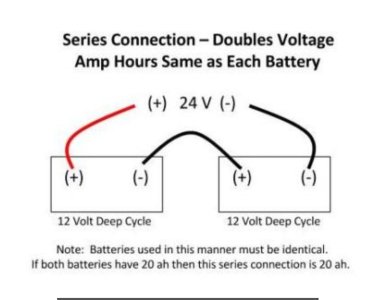@Czy_Horse... Being a retired electrician I'm sure you know what you are talking about, but Minn Kota suggests the following? I am currently using a 60 amp breaker with 15 ft. of 8 AWG wiring from two 31 series batteries to the motor plug-in on my 24 volt electric trolling motor which according to Minn Kota's chart is well within their specs. I'm a little confused so hoping you can fill me in with a little more info on the subject.
NOTICE: Wire Extension Length refers to the distance from the batteries to the trolling motor leads. Consult website for available thrust options. Maximum Amp Draw values only occur intermittently during select conditions and should not be used as continuous amp load ratings.
Reference United States Code of Federal Regulations: 33 CFR 183 – Boats and Associated Equipment ABYC E-11: AC and DC Electrical Systems on Boats
CONDUCTOR GAUGE AND CIRCUIT BREAKER SIZING TABLE
This conductor and circuit breaker sizing table are only valid for the following assumptions:- No more than 2 conductors are bundled together inside of a sheath or conduit outside of engine spaces.
- Each conductor has 105° C temp-rated insulation.
- No more than 5% voltage drop allowed at full motor power based on published product power requirements
| MOTOR THRUST/MODEL | MAX AMP DRAW | CIRCUIT BREAKER | WIRE EXTENSION LENGTH | ||||
|---|---|---|---|---|---|---|---|
| 5 FT | 10 FT | 15 FT | 20 FT | 25 FT | |||
| 30 lb. | 30 | 50 Amp @ 12 VDC | 10 AWG | 10 AWG | 8 AWG | 6 AWG | 4 AWG |
| 40 lb., 45 lb. | 42 | 50 Amp @ 12 VDC | 10 AWG | 8 AWG | 6 AWG | 4 AWG | 4 AWG |
| 50 lb., 55 lb. | 50 | 60 Amp @ 12 VDC | 8 AWG | 6 AWG | 4 AWG | 4 AWG | 2 AWG |
| 70 lb. | 42 | 50 Amp @ 24 VDC | 10 AWG | 10 AWG | 8 AWG | 8 AWG | 6 AWG |
| 80 lb. | 56 | 60 Amp @ 24 VDC | 8 AWG | 8 AWG | 8 AWG | 6 AWG | 6 AWG |
| 101 lb. | 46 | 50 Amp @ 36 VDC | 8 AWG | 8 AWG | 8 AWG | 8 AWG | 8 AWG |
| Engine Mount 101 | 50 | 60 Amp @ 36 VDC | 8 AWG | 8 AWG | 8 AWG | 8 AWG | 8 AWG |
| 112 lb. | 52 | 60 Amp @ 36 VDC | 8 AWG | 8 AWG | 8 AWG | 8 AWG | 8 AWG |
| Engine Mount 160 | 116 | (2) x 60 Amp @ 24 VDC | 6 AWG | 6 AWG | 4 AWG | 2 AWG | 2 AWG |
| E-Drive | 40 | 50 Amp @ 48 VDC | 10 AWG | 10 AWG | 10 AWG | 10 AWG | 10 AWG |
| Talon Shallow Water Anchor | 30 | 50 Amp @ 12 VDC | 10 AWG | 10 AWG | 8 AWG | 6 AWG | 4 AWG |
| Raptor Shallow Water Anchor | 70 | 50 Amp @ 12 VDC | 10 AWG | 8 AWG | 6 AWG | 4 AWG | 4 AWG |
Reference United States Code of Federal Regulations: 33 CFR 183 – Boats and Associated Equipment ABYC E-11: AC and DC Electrical Systems on Boats
Last edited:


